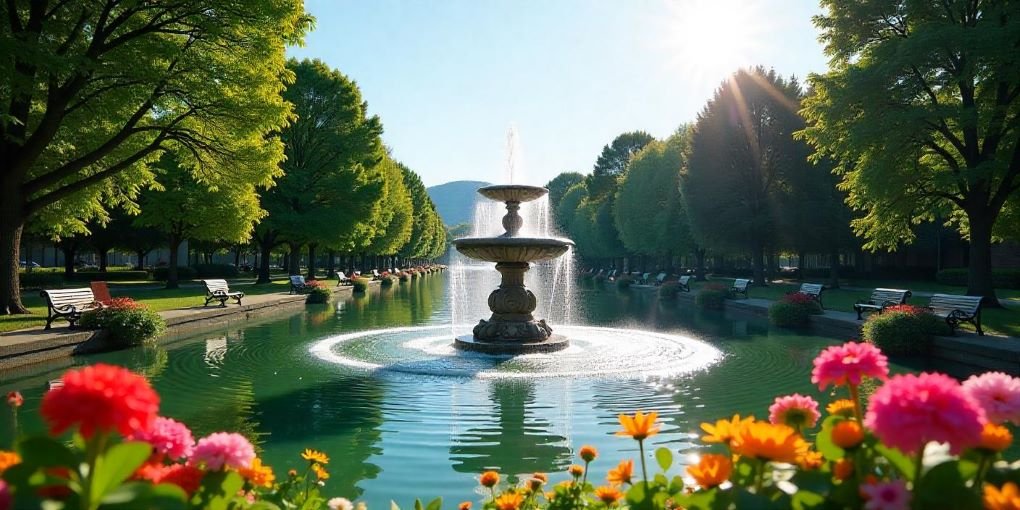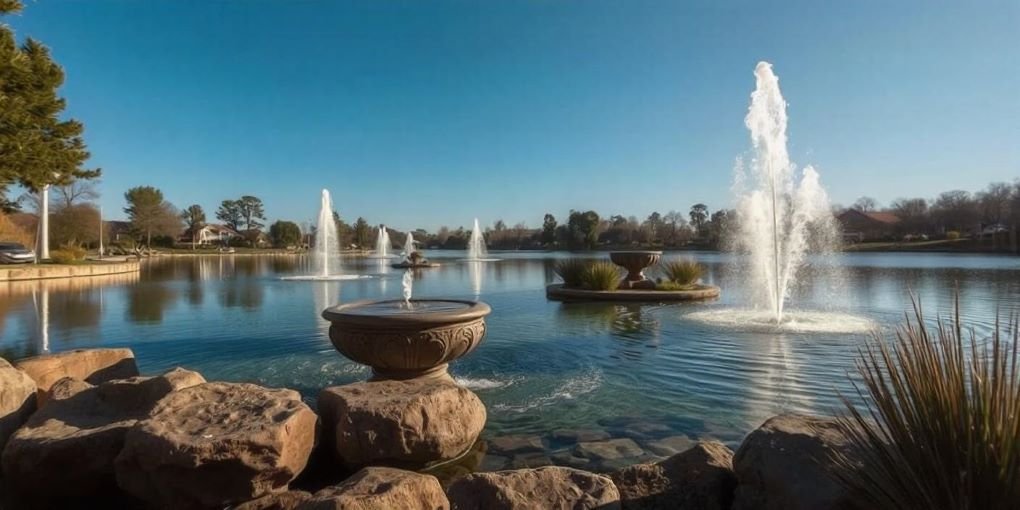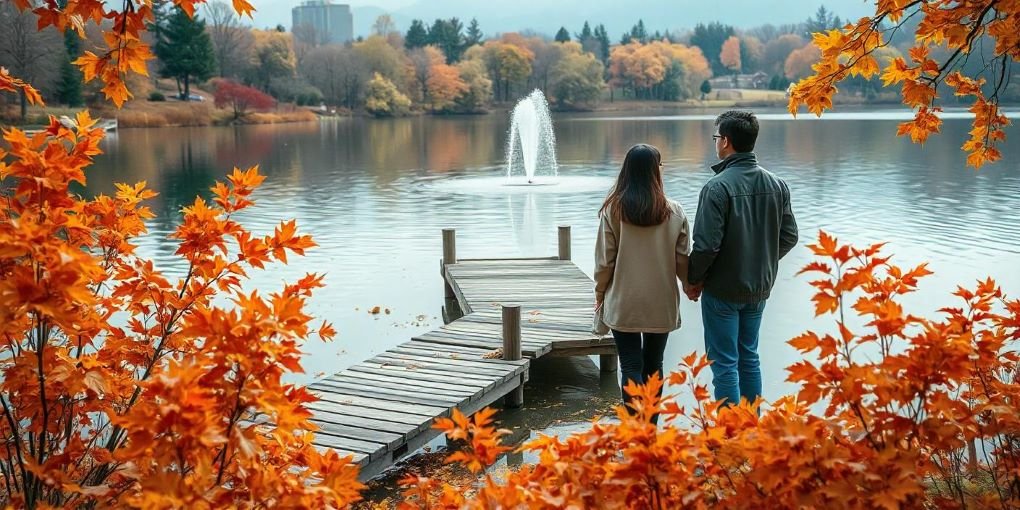Integrating water features into lakeside gardens can elevate the landscape’s aesthetics, enhance its natural ambiance, and create a serene retreat that blends with the existing environment. Whether it’s a cascading waterfall, a peaceful pond, or a trickling stream, each water element adds a unique dimension to the garden. This article delves deep into how to design, select, and maintain Water Feature Integration in Lakeside Gardens to ensure a seamless, appealing, and eco-friendly integration.
Understanding the Benefits of Water Features in Lakeside Gardens
Water features are not just decorative; they bring numerous benefits that enhance both the visual appeal and ecological health of your garden:
Enhanced Aesthetic Appeal
A well-integrated water feature acts as a focal point, drawing the eye and creating a picturesque scene. The movement and sound of water create a dynamic element that complements the stillness of the lake and surrounding plants.
Improved Ecosystem Health
Water elements, like small ponds or waterfalls can support local wildlife. Birds, frogs, dragonflies, and beneficial insects are naturally attracted to water sources, which help create a balanced ecosystem in your garden.
Stress Relief and Relaxation
The sound of water has a calming effect, which makes a garden an ideal place for unwinding. The gentle trickle or splash of a waterfall can mask unwanted noise, promoting a peaceful environment perfect for meditation or quiet reflection.
Temperature Regulation
Water features can aid in cooling the surrounding area by increasing humidity and promoting air circulation. This effect is particularly beneficial during hot summer months.
Choosing the Right Type of Water Feature
Selecting the appropriate water feature depends on the size of your garden, budget, and aesthetic preferences. Here are some popular options:
Waterfalls
A waterfall brings a dramatic yet natural feel to a garden. Whether you choose a multi-tiered cascade or a subtle rock waterfall, this feature pairs beautifully with both modern and rustic lakeside designs.
- Placement Tip: Position waterfalls near slopes or elevated sections of your garden to take advantage of gravity.
- Design Note: Use natural rocks and native plants around the waterfall to create a seamless connection with the lake.
Ponds
Ponds are a classic choice for larger lakeside gardens. They can host aquatic plants like water lilies and lotus, which not only look stunning but also promote a healthy ecosystem by providing shade and oxygen for fish and other aquatic life.
- Depth Consideration: For fish ponds, a minimum depth of 18 inches is essential to keep fish safe during varying temperatures.
- Plant Pairing: Add marginal plants like cattails and irises to soften pond edges and provide habitat for wildlife.
Fountains
Fountains are perfect for adding elegance and movement to smaller gardens. From tiered stone fountains to modern minimalist designs, fountains can be tailored to match your garden’s style.
- Maintenance Tip: Ensure that your fountain has a good filtration system to prevent algae buildup.
- Aesthetic Match: Use materials that complement your garden’s theme, such as stone for a natural look or metal for a contemporary touch.
Streams
A winding stream can mimic the natural flow of water and create a seamless link between the lake and your garden. Streams can be designed with shallow pools, gentle bends, and stepping stones for visual interest.
- Design Integration: Lay rocks of varying sizes and plant water-loving grasses along the edges to create a realistic appearance.
- Flow Control: Install pumps that allow you to control the water flow to ensure it remains steady and natural.
Designing Your Lakeside Water Feature
Incorporating Natural Elements
To create a cohesive look, use elements like stones, driftwood, and native plants that are already present around the lake. This will make the water feature appear as if it’s a natural part of the landscape.
Creating Visual Harmony
Place the water feature in a way that balances other aspects of the garden. For example, a waterfall can be offset by tall trees or shrubs, while a pond can be surrounded by flowering plants for color contrast.
Lighting for Ambiance
Adding lights to your water feature can create a magical effect during the evening. Use underwater LED lights for ponds or spotlights aimed at waterfalls to highlight the water’s movement.
- Sustainability Tip: Opt for solar-powered lights to conserve energy and reduce your garden’s carbon footprint.
Eco-Friendly Practices for Water Features
Sustainability should be at the forefront when designing water features. Here are ways to keep your water feature eco-friendly:
Utilize Recirculating Systems
Choose water features that use recirculating pumps, which conserve water by continuously cycling it through the system. This reduces the need for constant refilling and prevents water waste.
Native and Aquatic Plants
Incorporate native aquatic plants in and around the water feature to promote biodiversity. These plants provide oxygen to the water and help filter impurities naturally.
- Examples: Pickerelweed, water hyacinths, and duckweed are excellent choices for ponds.
Sustainable Materials
Use locally sourced rocks, reclaimed wood, and recycled materials for building your water feature. These materials not only create less harm to the environment but also integrate effortlessly into the natural surroundings.
Maintaining Your Lakeside Water Feature

Regular Cleaning
Keep water features clean by removing debris like leaves and twigs. This prevents clogs in pumps and keeps the water looking clear and inviting.
Preventing Algae Growth
Algae can be a common issue in stagnant water. To prevent this, use a combination of aquatic plants and a UV clarifier. Ensure your water feature gets some shade during the hottest part of the day to limit excessive algae growth.
Winterization Tips
In colder climates, it’s essential to winterize your water feature to protect it from damage. Drain the water, remove pumps, and cover the feature with a protective cover to prevent ice buildup.
Monitor Water Levels
Regularly check the water levels, especially in the summer months, as evaporation can lower water levels and damage pumps.
Adding Wildlife-Friendly Elements
To turn your lakeside garden into a haven for wildlife, consider these features:
Shelters and Nooks
Create small crevices and overhangs around ponds and waterfalls to give frogs, birds, and small mammals a place to rest or hide.
Birdbaths and Drinking Areas
Incorporate shallow birdbaths or small pools where birds and other animals can safely drink and bathe.
Fish-Friendly Environments
If you have a pond, adding fish such as koi or goldfish can be both decorative and beneficial for maintaining water health by controlling insect larvae.
Troubleshooting Common Water Feature Problems
Water Loss
Water evaporation is natural, but significant water loss could indicate a leak. Inspect liners and seals around your water feature regularly.
Pump Malfunction
Inspect the pump at regular intervals to verify that it is operating properly. If the water flow slows or stops, clean the pump to remove any clogs or buildup.
Unwanted Pests
Mosquitoes can breed in stagnant water. To deter them, introduce mosquito-eating fish like guppies or add a small fountain for water movement.
Integrating Water Features with Existing Landscaping
Integrating water features seamlessly into the existing landscape ensures your lakeside garden retains its natural beauty while enhancing it with water elements. Here’s how to achieve a cohesive look:
Blending with Surrounding Vegetation
Use plants that thrive near water sources to frame your water feature. Native grasses, ferns, and flowering shrubs like buttonbush or swamp milkweed are excellent options. These plants create a transition between the lake, water feature, and garden beds, tying the landscape together.
- Plant Layers: Arrange plants in layers, with taller grasses or shrubs at the back and shorter, flowering plants in the foreground to create depth and visual interest.
Rock Gardens and Waterfalls
Rocks and stones are essential in replicating natural scenery. Use a mix of large boulders and smaller stones around a waterfall or stream to create a realistic appearance. Rocks should be partially submerged and placed asymmetrically to mirror natural settings.
- Pro Tip: Add moss or lichens to stones to enhance their natural look over time and provide a habitat for small wildlife.
Pathways and Bridges
Incorporate pathways made from natural materials such as flagstone or wood to create access around your water feature. A small wooden bridge over a stream or between sections of a pond adds charm and functionality, inviting exploration.
Natural Edging
Avoid using harsh, man-made borders around your water feature. Instead, use natural edging with river rocks, driftwood, or logs to create a smooth transition between the water and surrounding soil. This approach enhances the naturalistic feel of the garden.
Designing Water Features for Different Garden Sizes

Small Gardens
For compact lakeside gardens, choose features like tabletop fountains, small birdbaths, or mini cascading waterfalls. These options maximize space while still adding the desired visual and auditory appeal.
- Vertical Elements: Use wall-mounted fountains or tall, narrow water features that save ground space and create an upward visual flow, giving the garden a more expansive feel.
Medium-Sized Gardens
Medium gardens can accommodate larger ponds or multi-tiered waterfalls. Adding a winding stream that connects to the lake or encircles a seating area can also create an intimate setting.
- Strategic Planting: Plant moisture-loving species like hostas or Japanese irises along the water’s edge for a lush, green backdrop.
Large Gardens
For expansive lakeside gardens, the possibilities are almost limitless. Consider a combination of elements such as a pond with a built-in waterfall, connected by streams and surrounded by rich plantings.
- Unique Features: Large gardens can also integrate special features like koi ponds with bridges, lily-covered ponds with built-in stepping stones, or even a small island accessible by a wooden footpath.
Sustainable Water Use and Conservation
Rainwater Harvesting
Collect rainwater in barrels and use it to refill your water features. This eco-friendly approach not only saves water but also diminishes reliance on tap water, which may contain chemicals that can affect plant and animal health.
Solar-Powered Pumps
Switch to solar-powered pumps for circulating water. These eco-friendly alternatives save electricity and can be installed easily with minimal maintenance.
- Backup Systems: Ensure you have a backup energy source for times when sunlight is insufficient, such as during cloudy days.
Natural Filtration Systems
Instead of chemical treatments, use plants like water lettuce, water hyacinths, or reed grasses as natural filters. These plants absorb excess nutrients, helping to control algae growth and maintain clear water.
Drought-Resistant Planting
Plant drought-tolerant species around the water feature to reduce the need for irrigation. Perennials like sedums, lavender, and ornamental grasses can thrive with minimal water while still complementing the garden’s look.
Creating Multi-Sensory Experiences
Water features are not just about sight and sound; they can stimulate all the senses for a fully immersive experience:
Soundscapes
Adjust the flow of water to create different types of sounds. A gently babbling stream creates a tranquil atmosphere, while a stronger waterfall produces a more dramatic and invigorating sound.
Fragrance
Plant fragrant flowers like jasmine, lilies, and honeysuckle near water features to provide delightful scents that enhance the sensory experience of the garden.
Touch
Incorporate smooth stones and gentle water flows that encourage interaction. Visitors can dip their hands into a shallow stream or touch the cool, water-worn rocks.
Safety Considerations for Water Features
Child and Pet Safety
If you have kids or animals, be sure to exercise additional caution. Install shallow water features or ensure deeper features are securely covered when not in use. Fencing or netting can be used as temporary safety measures.
Non-Slip Surfaces
Pathways near water features should be made from non-slip materials like textured stone or rubber mats to prevent accidents when wet.
Preventing Stagnant Water
Ensure that water in all features is kept moving to prevent stagnation, which can attract mosquitoes and create an unpleasant odor. A continuous flow of water from a pump or fountain helps keep water fresh.
Seasonal Care for Water Features

Spring and Summer Maintenance
Inspect for any damage caused by winter and perform required repairs. Clean and inspect the pump, trim back any overgrown plants, and introduce new aquatic plants to enhance your water feature’s appearance.
Autumn Preparations
Consistently remove leaves and debris that have fallen keep them from accumulating in the water and causing decay. Cover smaller water features with netting if necessary.
Winter Care
Drain fountains and smaller features that may freeze during winter. Larger ponds may need a pond heater or aerator to keep a section of water from freezing over completely, which is crucial for fish survival.
Budgeting for Water Feature Projects
Initial Costs
The initial cost of a water feature depends on its size, materials, and complexity. A small fountain might cost a few hundred dollars, while a fully customized pond with a waterfall can range into the thousands.
Maintenance Expenses
Budget for ongoing costs like pump electricity, cleaning supplies, and plant care. Using solar power and native plants can help minimize long-term expenses.
DIY vs. Professional Installation
Simple features like tabletop fountains or small ponds can be DIY projects, while larger, more complex designs might require the expertise of a landscape professional.
FAQs About Water Feature Integration in Lakeside Gardens
What is the best type of water feature for a lakeside garden?
The best type of water feature depends on the garden’s size, style, and personal preference. Small gardens benefit from fountains or tabletop features, while larger spaces can accommodate ponds, waterfalls, and streams that seamlessly blend into the natural lakeside environment.
How do I maintain water clarity in my water feature?
To maintain clear water, use a combination of natural filtration (plants like water lilies or hyacinths), a mechanical filtration system, and regular cleaning. Adding beneficial bacteria products can also help break down organic debris and prevent algae growth.
Are water features safe for children and pets?
Yes, but safety precautions should be taken. Shallow water features, secure covers, and non-slip surfaces can help ensure safety. Always supervise children and pets around deeper water features.
Can water features attract wildlife?
Absolutely. Water features can attract birds, frogs, dragonflies, and other beneficial wildlife. Adding native plants around the feature provides food and shelter, making the garden an inviting habitat.
What are the benefits of using solar-powered pumps?
Solar-powered pumps are eco-friendly, cost-effective, and easy to install. They reduce electricity costs and can operate even in remote areas without direct access to power outlets.
How can I prevent mosquitoes in my water feature?
To prevent mosquitoes, ensure the water is constantly moving with a pump or fountain. Adding mosquito-eating fish or introducing plants that naturally repel mosquitoes, like lemongrass, can also help.
Can I install a water feature myself, or do I need a professional?
It depends on the complexity of the project. or multi-level streams might benefit from professional installation to ensure proper water flow and structural integrity.
What plants work well around water features in lakeside gardens?
Plants that thrive in moist conditions, such as cattails, irises, hostas, and ferns, are ideal for planting around water features. Aquatic plants like water lilies can also be added to ponds for beauty and water health.
How do I winterize my water feature?
Winterizing involves draining or covering fountains, cleaning and storing removable pumps, and adding pond heaters or aerators for larger water features to prevent freezing. This protects the feature from damage during colder months.
Can I create a natural-looking water feature?
Yes, by using natural materials such as rocks, logs, and native plants. Position these elements in a way that mimics natural landscapes, and blend the water feature with existing foliage to create a cohesive, organic look.
How do I ensure the water feature doesn’t disrupt the natural ecosystem?
Use eco-friendly materials, avoid chemical treatments, and integrate native plants that support local wildlife. Recirculating water systems and natural filtration help maintain an eco-conscious approach.
Is it possible to build a budget-friendly water feature?
Yes, smaller fountains, pre-formed pond liners, and DIY kits are available for those on a budget. Using reclaimed materials or upcycling items like old basins can also create unique, affordable water features.
How can I add lighting to my water feature?
LED lights, underwater lights, and solar-powered spotlights are popular choices for illuminating water features. These can highlight the water’s movement and create a beautiful night-time effect while being energy-efficient.
What kind of fish can I add to my garden pond?
Common choices include koi, goldfish, and guppies. These fish add color and movement to the pond while helping control insect populations. Ensure the pond is deep enough for fish to survive seasonal changes.
